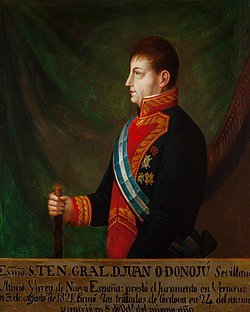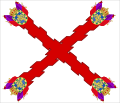| No. | Portrait | Governor | From | Until | Secretary of the Indies [1] | Valido
Secretary of the Universal Bureau
First Secretary of State | Regent | Monarch |
|---|
| 1 |  | Antonio de Mendoza | 14 November 1535 | 25 November 1550 | Vacant (Overseas Affairs hold by the President of the Council of the Indies) | No valido | No regency | 
Charles I |
| 2 |  | Luís de Velasco | 25 November 1550 | 31 July 1564 |
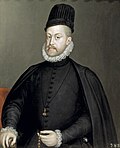
Philip II |
| Int. |  | Francisco Ceinos ,
Dean of the Audiencia | 1 August 1564 | 19 October 1566 |
| 3 |  | Gastón Carrillo de Peralta y Bosquete,
3rd Marquess of Falces | 19 October 1566 | 11 November 1567 |
| Acting |  | Alonso de Muñoz ,
Royal commissioner of New Spain | 11 November 1567 | 15 April 1568 |
Luis Carrillo,
Royal commissioner of New Spain |
Francisco Ceinos,
Dean of the Audiencia | 15 April 1568 | 5 November 1568 |
| 4 |  | Martín Enríquez de Almanza | 5 November 1568 | 4 October 1580 |
| 5 |  | Lorenzo Suárez de Mendoza,
4th Count of La Coruña | 4 October 1580 | 19 June 1583 |
| Int. |  | Luis de Villanueva y Zapata ,
Dean of the Audiencia | 19 June 1583 | 25 September 1584 |
| 6 |  | Pedro de Moya y Contrerás
(Archbishop of Mexico) | 25 September 1584 | 17 October 1585 |
| 7 |  | Álvaro Manrique de Zúñiga
1st Marquess of Villamanrique | 17 October 1585 | 27 January 1590 |
| 8 |  | Luís de Velasco
Marquess of Salinas | 27 January 1590 | 5 November 1595 |
| 9 |  | Gaspar de Zúñiga Acevedo y Fonseca,
5th Count of Monterrey | 5 November 1595 | 27 October 1603 |
 Duke of Lerma [2] | 
Philip III |
| 10 |  | Juan de Mendoza y Luna,
Marquess of Montesclaros | 27 October 1603 | 2 July 1607 |
| 11 |  | Luís de Velasco,
Marquess of Salinas | 2 July 1607 | 19 June 1611 |
| 12 |  | García Guerra , O.P.
(Archbishop of Mexico) | 19 June 1611 | 22 February 1612 |
| Int. |  | Pedro Otárola,
Dean of the Audiencia | 22 February 1612 | 18 October 1612 |
| 13 |  | Diego Fernández de Córdoba,
Marquess of Guadalcázar and Count of Posadas | 18 October 1612 | 14 March 1621 |
 Cristóbal Gómez de Sandoval [2] |
| Acting |  | Paz de Valecillo,
Dean of the Audiencia | 14 March 1621 | 11 September 1621 |
 Philip IV |
 Baltasar de Zúñiga [2] |
| 14 |  | Diego Carrillo de Mendoza y Pimentel,
1st Marquess of Gélves | 21 September 1621 | 1 November 1624 |
 Count-Duke of Olivares [2] |
Vacant
Due to the discrepancy on the arrival of successor Viceroy
from 1 to 3 November 1624. |
| 15 |  | Rodrigo Pacheco y Osorio de Toledo,
3rd Marquess of Cerralvo | 3 November 1624 | 16 September 1635 |
| 16 |  | Lope Díez de Aux de Armendáriz,
Marquess of Cadreita | 16 September 1635 | 28 August 1640 |
| 17 |  | Diego Roque López Pacheco Cabrera y Bobadilla,
7th Duke of Escalona, 7th Marquess of Villena and 7th Count of Xiquena | 28 August 1640 | 10 June 1642 |
| 18 |  | Juan de Palafox y Mendoza
(Bishop of Puebla) | 10 June 1642 | 23 November 1642 |
| 19 |  | García Sarmiento de Sotomayor,
2nd Count of Salvatierra and Marquess of Sobroso | 23 November 1642 | 14 May 1648 |
 Luis de Haro [2] |
| 20 |  | Marcos de Torres y Rueda
(Bishop of Yucatan) | 15 May 1648 | 22 April 1649 |
| Int. |  | Matías de Peralta,
Dean of the Audiencia | 22 April 1649 | 28 June 1650 |
| 21 |  | Luis Enríquez de Guzmán,
9th Count of Alba de Liste and Marquess of Villaflor | 28 June 1650 | 15 August 1653 |
| 22 |  | Francisco Fernández de la Cueva,
8th Duke of Alburquerque, Marquess of Cuéllar, Count of Ledesma and of Huelma | 15 August 1653 | 16 September 1660 |
| 23 |  | Juan de Leyva de la Cerda,
Marquess of Adrada | 16 September 1660 | 29 June 1664 |
| No valido [3] |
| 24 |  | Diego Osorio de Escobar y Llamas
(Bishop of Puebla) | 29 June 1664 | 15 October 1664 |
| 25 |  | Antonio Sebastián de Toledo Molina y Salazar,
2nd Marquess of Mancera | 16 October 1664 | 20 November 1673 |
 Juan Everardo Nithard [2] | 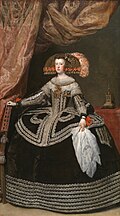 Mariana of Austria [4] Mariana of Austria [4] | 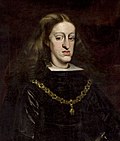
Charles II |
 Fernando de Valenzuela [2] |
| 26 |  | Pedro Nuño Colón de Portugal y Castro,
6th Duke of Veragua, 6th Marquess of Jamaica and 6th Count of Gelves | 20 November 1673 | 13 December 1673 |
| 27 |  | Payo Enríquez de Rivera Manrique , O.S.A.
(Bishop of Guatemala and Archbishop of Mexico) | 13 December 1673 | 7 November 1680 |
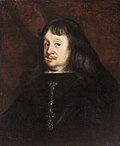 John Joseph of Austria [5] | No regency |
 Duke of Medinaceli [5] |
| 28 |  | Tomás Antonio Manuel Lorenzo de la Cerda y Aragón
3rd Marquess of La Laguna de Camero Viejo | 7 November 1680 | 16 June 1686 |
| Count of Oropesa [5] |
| 29 |  | Melchor Portocarrero y Lasso de la Vega,
3rd Count of Monclova | 16 June 1686 | 20 November 1688 |
| 30 |  | Gaspar Melchor Baltasar de la Cerda Silva Sandoval y Mendoza,
8th Count of Galve, Lord of Salcedón and Tortola | 20 November 1688 | 27 February 1696 |
 Cardinal Portocarrero [2] |
| 31 |  | Juan de Ortega Cano Montañez y Patiño
(Bishop of Durango, Guatemala, Michoacán and Archbishop of Mexico) | 27 February 1696 | 18 December 1696 |
| 32 |  | José Sarmiento Valladares Arines de Romay,
1st Duke of Atrisco, Count of Moctezuma and of Tula | 18 December 1696 | 4 November 1701 |
| Count of Oropesa [5] |
 Cardinal Portocarrero [2] |
 Cardinal Portocarrero [6] |
| Government Board of the Realms [7] | Vacant [8] |
| Antonio de Ubilla [9] | 
Philip V |
| 33 |  | Juan de Ortega Cano Montañez y Patiño
(Archbishop of Mexico) | 4 November 1701 | 27 November 1702 |  Cardinal Portocarrero [10] |
| 34 |  | Francisco V Fernández de la Cueva Enríquez y Fernández de la Cueva,
10th Duke of Alburquerque and Marquess of Cuéllar | 27 November 1702 | 13 November 1710 |
| No regency |
| Marquis of Mejorada del Campo [9] |
| 35 |  | Fernando de Alencastre Noroña y Silva,
1st Duke of Linares and Marquess of Valdefuentes | 13 November 1710 | 16 July 1716 |
| Manuel de Vadillo y Velasco [9] |
 José de Grimaldo [9] |
| Bernardo Tinajero de la Escalera [11] |
| No secretary |
| 36 |  | Baltasar de Zúñiga Guzmán Sotomayor y Mendoza,
1st Duke of Arión and Marquess of Valero | 16 July 1716 | 15 October 1722 |

Miguel Fernández Durán [11] |
| Andres Matías de Pes Marzaraga [11] |
| 37 |  | Juan de Acuña y Bejarano,
2nd Marquess of Casa Fuerte | 15 October 1722 | 17 March 1734 |
| No secretary |
| Antonio de Sopeña y Mioño [11] |
| Juan Bautista de Orendáin [9] |

Louis I
From 1700 to 1724, Philip V was the king; then from 1724 to 1746. Louis I only reigned in 1724. |

Philip V |
 José de Grimaldo [9] |
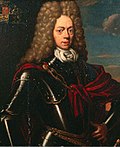 Baron Ripperda [9] |
 José de Grimaldo [9] |
 José de Patiño y Rosales [11] José de Patiño y Rosales [11] |
| Juan Bautista de Orendáin [9] |
| 38 |  | Juan Antonio de Vizarrón y Eguiarreta
(Archbishop of Mexico) | 17 March 1734 | 17 August 1740 |
 José de Patiño y Rosales [12] |
| Mateo Pablo Díaz de Lavandero [11] |  Marquess of Villarías [12] |
 Marquess of Villarías [11] Marquess of Villarías [11] |
| 39 |  | Pedro de Castro Figueroa y Salazar,
1st Duke of La Conquista and 1st Marquess of Gracia Real | 17 August 1740 | 22 August 1741 |
| Int. |  | Pedro Malo de Villavicencio ,
President of the Audiencia | 23 August 1741 | 2 November 1742 |
| 40 |  | Pedro Cebrián y Agustín,
5th Count of Fuenclara | 3 November 1742 | 9 July 1746 |
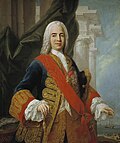 Marquess of Ensenada [11] Marquess of Ensenada [11] |
| 41 |  | Juan Francisco de Güemes y Horcasitas,
1st Count of Revillagigedo | 9 July 1746 | 9 November 1755 | 
Ferdinand VI |
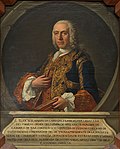 José de Carvajal [12] |
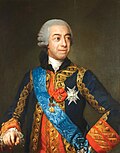 Duke of Huéscar (Interim) [12] |
 Ricardo Wall [12] |
 Ricardo Wall (Interim) [13] Ricardo Wall (Interim) [13] |
| Julián de Arriaga y Ribera [13] |
| 42 |  | Agustín de Ahumada y Villalón,
Marquess of Amarillas | 10 November 1755 | 5 February 1760 |
 Elisabeth Farnese [14] | 
Charles III |
| No regency |
| Int. |  | Francisco Antonio de Echávarri ,
Dean of the Audiencia | 5 February 1760 | 28 April 1760 |
| 43 |  | Francisco Cajigal de la Vega | 28 April 1760 | 5 October 1760 |
| 44 |  | Joaquín de Montserrat,
Marquess of Cruillas | 5 October 1760 | 24 August 1766 |
 Jerónimo Grimaldi [12] |
| 45 |  | Carlos Francisco de Croix,
Marquess of Croix | 24 August 1766 | 22 September 1771 |
| 46 |  | Antonio María de Bucareli y Ursúa | 22 September 1771 | 9 April 1779 |
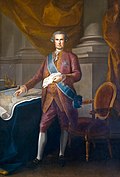 Marquess of Sonora [13] Marquess of Sonora [13] |
 Count of Floridablanca [12] |
| Int. |  | Francisco Romá y Rosell ,
Regent of the Audiencia | 10 April 1779 | 22 August 1779 |
| 47 |  | Martín de Mayorga Ferrer ,
Captain General of Guatemala | 23 August 1779 | 28 April 1783 |
| 48 |  | Matías de Gálvez y Gallardo ,
Captain General of Guatemala | 28 April 1783 | 20 October 1784 |
| – |  | Vicente de Herrera y Rivero,
Regent of the Audiencia | 20 October 1784 | 17 June 1785 |
| 49 |  | Bernardo de Gálvez y Madrid,
1st Viscount of Galveston and 1st Count of Gálvez | 17 June 1785 | 30 November 1786 |
| Int. |  | Eusebio Sánchez Pareja y Beleño
Regent of the Audiencia | 30 November 1786 | 8 May 1787 |
| 50 |  | Alonso Núñez de Haro y Peralta
(Archbishop of Mexico) | 8 May 1787 | 16 August 1787 |
 Count of Floridablanca (Interim) [13] Count of Floridablanca (Interim) [13] |
 Antonio Porlier [15] Antonio Porlier [15]
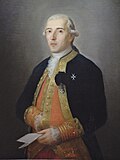 Antonio Valdés y Fernández Bazán [16] Antonio Valdés y Fernández Bazán [16] |
| 51 |  | Manuel Antonio Flórez Maldonado | 16 August 1787 | 16 October 1789 |
| 52 |  | Juan Vicente de Güemes Pacheco de Padilla y Horcasitas,
2nd Count of Revillagigedo | 17 October 1789 | 11 July 1794 |

Charles IV |
| No secretary (affairs of Indies distributed among different secretariats) |  Count of Aranda (Interim) [12] |
 Manuel Godoy [12] |
| 53 |  | Miguel de la Grúa Talamanca de Carini y Branciforte,
1st Marquess of Branciforte | 12 July 1794 | 31 May 1798 |
 Francisco de Saavedra [12] |
| 54 |  | Miguel José de Azanza Alegría,
1st Duke of Santa Fe | 31 May 1798 | 30 April 1800 |
 Mariano Luis de Urquijo [12] |
| 55 |  | Félix Berenguer de Marquina | 30 April 1800 | 4 January 1803 |
 Pedro Cevallos Guerra [12] |
| 56 |  | José de Iturrigaray [17] | 4 January 1803 | 16 September 1808 |
 Gonzalo O'Farril [12] |
 Pedro Cevallos Guerra [12] |  Ferdinand VII Ferdinand VII |
 Miguel José de Azanza [18] Miguel José de Azanza [18] |  Mariano Luis de Urquijo [12] | 
Joseph I [19] |
| 57 |  | Pedro de Garibay [17] | 16 September 1808 | 19 July 1809 |
| 58 |  | Francisco Javier de Lizana y Beaumont
(Archbishop of Mexico) [17] | 19 July 1809 | 8 May 1810 |
| 59 |  | Pedro Catani [17] | 8 May 1810 | 14 September 1810 |
| 60 |  | Francisco Javier Venegas,
1st Marquess of Reunión and of New Spain [17] | 14 September 1810 | 4 March 1813 |
| 61 |  | Félix María Calleja del Rey,
1st Count of Calderón [17] | 4 March 1813 | 20 September 1816 |
| No secretary |  Juan O'Donoju (Interim) [12] |
| Fernando de Laserna (Interim) [12] |
| Manuel Antonio de la Bodega y Mollinedo [20] | José Luyando (Interim) [12] |  Ferdinand VII |
 Miguel de Lardizabal [20] Miguel de Lardizabal [20] |  José Miguel de Carvajal-Vargas [12] |
 Pedro Cevallos Guerra [12] |
| No secretary | Jaun Estebán Lozano de Torres [12] |
 Pedro Cevallos Guerra [12] |
| 62 |  | Juan Ruiz de Apodaca,
1st Count of Venadito | 20 September 1816 | 5 July 1821 |
 José García de León [12] |
 Carlos Martínez de Irujo (Interim) [12] |
 Manuel González Salmón (Interim) [12] |
 Joaquín José Melgarejo [12] |
| Antonio González Salmón (Interim) [20] |
| Juan Jabat Aztal [12] |
 Antonio Porcel Román [20] Antonio Porcel Román [20] |
 Evaristo Pérez de Castro [12] |
| Ramón Gil de la Cuadra [20] |
| Antonio de Guilleman(Interim) [20] | Joaquín Anduaga Cuenca(Interim) [12] |
| Francisco de Paula Escudero (Interim) [12] |
| Ramón Olaguer Feliú [20] |
 Eusebio Bardají y Azara [12] |
| Ramón López Pelegrín [20] |
| 63 |  | Francisco Novella Azabal Pérez y Sicardo | 15 July 1821 | 21 July 1821 |
| 64 |  | Juan O'Donojú | 21 July 1821 | 28 September 1821 |
